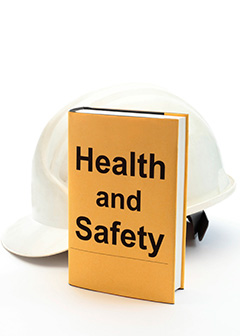How to Become a Health and Safety Engineer About this section

Health and safety engineers inspect facilities, machinery, and safety equipment to identify and correct potential hazards.
Health and safety engineers must have a bachelor’s degree, typically in electrical, chemical, mechanical, industrial, or some other engineering discipline. Employers value practical experience, so cooperative-education engineering programs at universities are valuable as well.
Education
High school students interested in becoming a health and safety engineer will benefit from taking high school courses in mathematics, such as algebra, trigonometry, and calculus; and science, such as biology, chemistry, and physics.
Entry-level jobs as a health and safety engineer require a bachelor's degree. Bachelor's degree programs typically are 4-year programs and include classroom, laboratory, and field studies in applied engineering. In addition to programs in mechanical, electrical, and industrial engineering, programs in systems engineering and fire protection engineering are offered at some colleges and universities. Students interested in becoming a health and safety engineer should seek out coursework in occupational safety and health, industrial hygiene, ergonomics, or environmental safety.
Students interested in entering the relatively new field of software safety engineering may pursue a degree in computer science.
Most colleges and universities offer cooperative programs, which allow students to gain practical experience while completing their education.
A few colleges and universities offer 5-year accelerated programs that lead to both a bachelor’s and a master’s degree. A master’s degree allows engineers to enter the occupation at a higher level, where they can develop and implement safety systems.
ABET (formerly the Accreditation Board for Engineering and Technology) accredits programs in engineering.
Important Qualities
Creativity. Health and safety engineers are asked to produce designs showing potential problems and remedies for them. They must be creative to work with unique situations with each project.
Deductive reasoning. Health and safety engineers must be able to interpret federal and state regulations and understand the goals of those regulations so that they can propose proper designs for specific work environments.
Problem sensitivity. Health and safety engineers must identify potential hazards and problems before they cause material damage or become a threat to peoples’ health. Thus, these engineers must be able to sense hazards to humans and property wherever they may arise in the workplace or, for consumer products, in the home.
Problem-solving skills. In designing solutions for entire organizational operations, health and safety engineers must take into account processes from more than one system at the same time. In addition, they must try to anticipate a range of human reactions to the changes they recommend.
Systems analysis. Health and safety engineers must observe and learn how operations currently function so that they can identify risks to people and property. This type of observation and learning requires the ability to think in terms of overall processes within an organization. Health and safety engineers can then recommend systemic changes to minimize risks.
Licenses
Only a few states require health and safety engineers to be licensed. Licensure is generally advised for those opting for a career in systems safety engineering.
Licensed engineers are called professional engineers (PEs). Licensure generally requires the following:
- A degree from an ABET-accredited engineering program
- A passing score on the Fundamentals of Engineering (FE) exam
- Relevant work experience, typically at least 4 years
- A passing score on the Professional Engineering (PE) exam
The initial Fundamentals of Engineering (FE) exam can be taken after graduation from college. Engineers who pass this exam are commonly called engineers in training (EITs) or engineer interns (EIs). After getting suitable work experience, EITs and EIs can take the second exam, called the Principles and Practice of Engineering.
Several states require continuing education for engineers to keep their license. Most states recognize licensure from other states, if the licensing state’s requirements meet or exceed their own licensure requirements.
Certification
Health and safety engineers typically have professional certification. Most earn either the Certified Safety Professional (CSP) certification, awarded by the Board of Certified Safety Professionals, or the Certified Industrial Hygienist (CIH) certification, awarded by the American Board of Industrial Hygiene. Certification is generally needed to advance into management positions.
Advancement
New health and safety engineers usually work under the supervision of experienced engineers. To move to more difficult projects with greater independence, a graduate degree is generally required. This advanced degree allows an engineer to develop and implement safety programs. Certification as a safety professional or as an industrial hygienist is generally required for entry into management positions.









